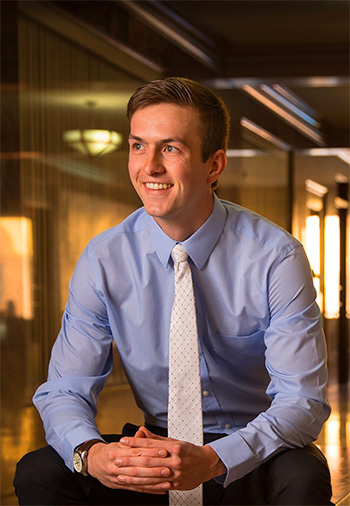Sophisticated investment tools for every client
Sophisticated investment tools for every client

Eric Sajdak, ChFC • Green Bay, WI
Safeguard Wealth Management
Read full biography below
I studied finance in college, along with computer science and mathematics. While I enjoyed my finance courses and the interaction with my professors, it felt like I was spinning my wheels. I had already read much of the course material on my own. I decided it was important to get some real-world experience and was excited to obtain an internship with a national financial-services company in their financial-planning and investment group.
The one-year internship was a very valuable experience. I learned how impactful financial education and planning could be to individuals and families. The direction our firm recommended for a family’s finances and investments could be influential for the rest of their financial lives. That is a huge responsibility. I worked with experienced advisors on client cases, and that provided a lot of insight on how the process can work best. I was exposed to several third-party investment managers and saw how they applied their philosophies to working investment strategies.
The experience also taught me about what kind of advisor I wanted to be. I determined that when I had my own practice, my relationships with clients would be less transactional and based more on holistic planning.

- Cash flow: Do you have a good handle on an income and expense statement for your household? Are you systematically saving toward retirement?
- Liquidity and debt: Do you have at least six months of expenses covered in a liquid, guaranteed investment vehicle? Do you have a debt-reduction plan in place?
- Protection: Have you recently reviewed a complete insurance coverage plan, including auto, home, life, and business? Would your survivors have enough income to continue to achieve their life goals (home ownership, college, income for expenses, etc.)?
- Retirement income: What after-tax income is required to fund your retirement goals? What income streams will you have? How can your assets and resources best be positioned for the growth needed to achieve your required retirement income?
- Investing: Does your current portfolio really match your appetite for risk? Is it “stress-tested” to withstand the next major market displacement? Is it strategically diversified (not just stocks and bonds, but across management styles, asset classes, and different managers)?
- Estate: Have you met with an estate attorney? Is your estate plan up to date and reflecting any beneficiary changes? Has your plan been coordinated by financial, tax, and legal professionals?
In either case, we spend a lot of time discussing risk with clients, determining their true risk tolerance, and understanding their expectations around investments. This is where we focus on client education. Many clients will say that they are very uncomfortable if their investments lost in the area of 20% to 25%. When we actually analyze their current portfolio allocations, they may have a risk exposure exceeding 50% in terms of potential drawdowns. That can surprise many people.
While there is some truth to that, we explain that that is really not the whole story. The S&P 500 has a set of rules, it rebalances, and it loses and gains member companies. In many ways, it is an active investment and people just do not realize how the index components are determined and how they can change over time. But more importantly, while the gains in the S&P 500 can be impressive in a bull market, the drawdowns it can experience make it anything but a conservative investment. By our definition, it is an active investment—just not a particularly good one as far as risk-adjusted returns go.
The problem with financial markets is that we will inevitably face periods where there is anything but a normal distribution of statistics. Things that should not happen over several lifetimes have happened twice in this century. That is one of the core reasons that I think approaching investments from a quantitative basis that focuses on risk-adjusted returns beats passive investing every time. It does so both on an absolute level over longer time frames and in terms of offering clients an investing experience more in line with their true risk tolerance.

Active investing is the equivalent of arming your family with the latest GPS technology, constantly updated weather and traffic reports, and a first-class vehicle that can be easily maneuvered to handle all sorts of road conditions along an optimized route. While no investing approach works ideally at all times, which mode of travel, or investing, should make the most sense to clients and their families?
This simple story seems to resonate well with people. I think it captures the essence of the message we want to communicate about using the most sophisticated tools in today’s markets to help our clients to achieve their financial and investment goals.
 Eric Sajdak is a partner at Safeguard Wealth Management, a fee-based advisory firm and registered investment advisor located in Green Bay, Wisconsin. In addition to working with his own client base, Mr. Sajdak is chief investment advisor and the director of college planning at the firm.
Eric Sajdak is a partner at Safeguard Wealth Management, a fee-based advisory firm and registered investment advisor located in Green Bay, Wisconsin. In addition to working with his own client base, Mr. Sajdak is chief investment advisor and the director of college planning at the firm.
After beginning his career in the financial-planning and investment division of a Fortune 500 company, Mr. Sajdak later became managing partner at Sajdak Lenz Investments. He says he then helped found Fox River Capital in 2016 to work with “two very talented partners” who both share his passion for “giving clients access to sophisticated investment tools and advice.”
Mr. Sajdak, who has earned the Chartered Financial Consultant (ChFC) designation from the American College, provides clients with a variety of services, including financial planning, retirement income planning, investment recommendations, portfolio management, and planning for college funding.
Outside of the office, Mr. Sajdak enjoys competing in endurance sports, “hitting up the slopes,” and watching the Green Bay Packers. He lives in Appleton, which he says has a “great blend of smaller-town values and community” with many big-city amenities and entertainment options.
Disclosure: Safeguard Wealth Management is a registered investment advisor in the state of Wisconsin.
Photography by Mike Roemer


